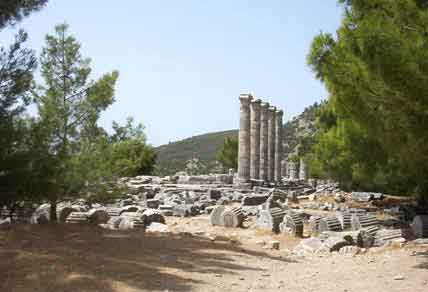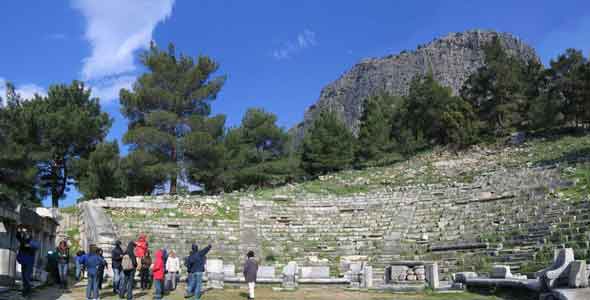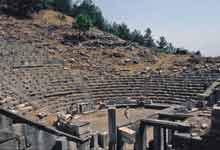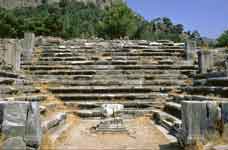.
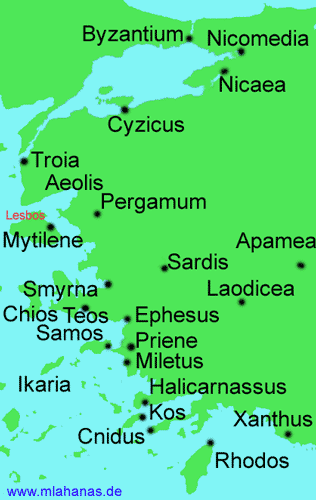
Priene (mod. Samsun kale) was an ancient city of Ionia on the foot-hills of Mycale, about 6 miles north of the Maeander. It was formerly on the sea coast, but now lies some miles inland.
It is aid to have been founded by Ionians under Aegyptus, a son of Belus. Sacked by Ardys of Lydia, it revived and attained real prosperity under its "sage," Bias, in the middle of the 6th century BC. Cyrus captured it in 545 BC; but it was able to send twelve ships to join the Ionic Revolt (499 BC-494 BC). Disputes with Samos, and the troubles after Alexander's death, brought Priene low, and Rome had to save it from the kings of Pergamum and Cappadocia in 155.
Orophernes, the rebellious brother of the Cappadocian king, who had deposited a treasure there and recovered it by Roman intervention, restored the temple of Athena as a thank-offering. Under Roman and Byzantine dominion Priene had a prosperous history. It passed into Muslim hands late in the 13th century.
The ruins, which lie in successive terraces, were the object of missions sent out by the English Society of Dilettanti in 1765 and 1868, and have seen thoroughly laid open by Dr Th. Wiegand (1895-1899) for the Berlin Museum. The city, as rebuilt in the 4th and 3rd centuries, was laid out on a rectangular scheme. It faced south, its acropolis rising nearly 700 feet behind it. The whole area was enclosed by a wall 7 feet thick with towers at intervals and three principal gates.
On the lower slopes of the acropolis was a shrine of Demeter. The town had six main streets, about 20 feet wide, running east and west and fifteen streets about 10 ft. wide crossing at right angles, all being evenly spaced; and it was thus divided into about 80 insulae. Private houses were apportioned four to an insula. The systems of water-supply and drainage can easily be discerned. The houses present many analogies with the earliest Pompeian. In the western half of the city, on a high terrace north of the main street and approached by a fine stairway, was the temple of Athena Polias, a hexastyle peripterial structure built by Pythias, the architect of the Mausoleum. Under the basis of the statue of Athena were found in 1870 silver tetradrachms of Orophernes, and some jewelry, probably deposited at the time of the Cappadocian restoration.
Fronting the main street is a series of halls, and on the other side is the fine market place. The municipal buildings, Roman gymnasium, and well preserved theatre lie to the north, but, like all the other public structures, in the centre of the plan. Temples of Isis and Asclepius have been laid bare. At the lowest point on the south, within the walls, was the large stadium, connected with a gymnasium of Hellenistic times.
See Society of Dilettanti, Ionian Antiquities (1821), vol. ii.; Th. Wiegand and H. Schrader, Priene (1904); on inscriptions (360) see Hiller von Gartringen, Inschriften van Priene (Berlin, 1907), with collection of ancient references to the city.
This article incorporates text from the public domain 1911 Encyclopædia Britannica.

On reaching Priene, Alexander the Great made a further dedication to Athena. There the townspeople were laying out their new city and building a temple to its patron goddess. Alexander offered funds to complete the temple, and the inscription on this wall block, cut into a block of marble, records his gift. The inscription was found in the nineteenth century by the architect-archaeologist Richard Pullan leading an expedition on behalf of the Society of Dilettanti. It reads: 'King Alexander dedicated the Temple to Athena Polias'. Length: 120.5 cm Width: 49.5 cm Height: 1.25 m Width: 1.25 m (about) Thickness: 48.25 cm
Gift of the Society of Dilettanti , GR 1870.3-20.88 (Inscription 399 and 400) Room 78, Classical inscriptions, north wall
B.F. Cook, Greek inscriptions (London, The British Museum Press, 1987), pp. 21-22, fig. 12, Image and information from http://www.thebritishmuseum.ac.uk
The Ionians who settled at Myus and Priene, they too took the cities from Carians. The founder of Myus was Cyaretus the son of Codrus, but the people of Priene, half Theban and half Ionian, had as their founders Philotas, the descendant of Peneleus, and Aepytus, the son of Neileus. The people of Priene, although they suffered much at the hands of Tabutes the Persian and afterwards at the hands of Hiero, a native, yet down to the present day are accounted Ionians.
Persons
Hermogenes of Priene, Hellenistic architect
| Ancient Greece
Science, Technology , Medicine , Warfare, , Biographies , Life , Cities/Places/Maps , Arts , Literature , Philosophy ,Olympics, Mythology , History , Images Medieval Greece / Byzantine Empire Science, Technology, Arts, , Warfare , Literature, Biographies, Icons, History Modern Greece Cities, Islands, Regions, Fauna/Flora ,Biographies , History , Warfare, Science/Technology, Literature, Music , Arts , Film/Actors , Sport , Fashion --- |
Retrieved from "http://en.wikipedia.org/"
All text is available under the terms of the GNU Free Documentation License


